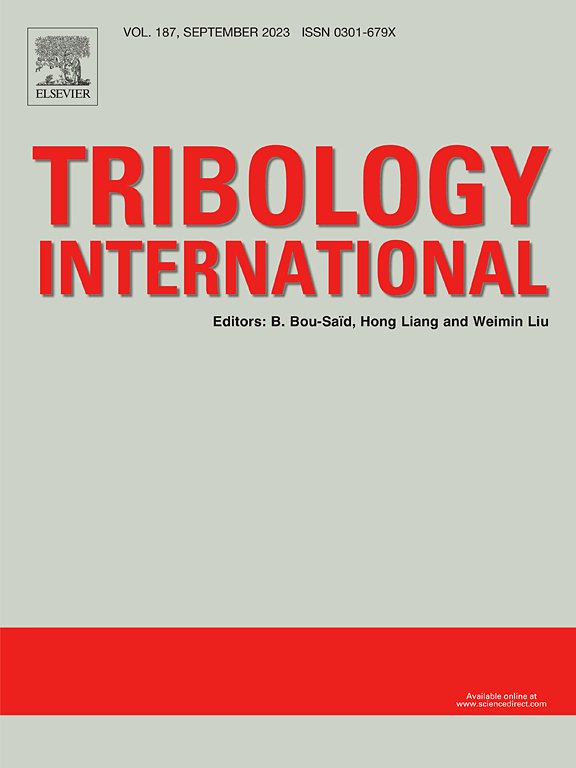弹性流体接触中水基润滑剂成膜及压力-粘度关系的研究
IF 6.1
1区 工程技术
Q1 ENGINEERING, MECHANICAL
引用次数: 0
摘要
了解润滑油的弹性流体动力(EHL)油膜形成和压力-粘度响应对于设计滚动/滑动摩擦接触非常必要。本文研究了四种配制的水基润滑油(甘油-水、乙二醇-水和离子液体-水)和一种参考油在中等高压(齿轮和轴承应用中的典型高压)下的 EHL 行为。使用带光学干涉仪的盘上球摩擦仪测量水基润滑油的油膜厚度。结果凸显了油膜形成对夹带速度、滑辊比 (SRR)、温度和润滑剂成分的敏感性。在高温条件下,蒸发造成的水分损失对油膜的形成有很大影响。此外,在乙二醇-水溶液中观察到油膜厚度异常增加,这可能是由于复杂的摩擦学条件造成的。此外,还讨论了水基润滑油的经典 Hamrock-Dowson 薄膜厚度方程的局限性。此外,还使用光学干涉测量法和高压粘度计法估算了水基润滑剂的压力粘度系数。还研究了水含量对压力-粘度系数的影响,结果表明,水含量越高,粘度的压力和温度依赖性越小。本文章由计算机程序翻译,如有差异,请以英文原文为准。
An investigation of film formation and pressure-viscosity relationship of water-based lubricants in elastohydrodynamic contacts
Understanding elastohydrodynamic (EHL) film formation and the pressure-viscosity response of lubricants is necessary for designing rolling/sliding tribological contacts. This article investigates the EHL behaviour of four formulated water-based lubricants (glycerol-water, glycol-water, and ionic liquid-water) and one reference oil under moderately high pressures, typical in gears and bearings applications. A ball-on-disc tribometer with optical interferometry was employed to measure the film thickness of the water-based lubricants. The results highlight the sensitivity of film formation to entrainment speed, slide-to-roll ratio (SRR), temperature, and lubricant composition. Water loss due to evaporation significantly impacts film formation at high temperatures. Additionally, an unusual increase in film thickness was observed for the glycol-water solution, likely due to complex tribological conditions. The limitations of the classical Hamrock-Dowson film thickness equation for water-based lubricants are also discussed. Furthermore, pressure-viscosity coefficients of the water-based lubricants were estimated using both optical interferometry and high-pressure viscometer methods. The effect of water content on the pressure-viscosity coefficient was also examined, revealing that higher water content leads to reduced pressure and temperature dependence of viscosity.
求助全文
通过发布文献求助,成功后即可免费获取论文全文。
去求助
来源期刊

Tribology International
工程技术-工程:机械
CiteScore
10.10
自引率
16.10%
发文量
627
审稿时长
35 days
期刊介绍:
Tribology is the science of rubbing surfaces and contributes to every facet of our everyday life, from live cell friction to engine lubrication and seismology. As such tribology is truly multidisciplinary and this extraordinary breadth of scientific interest is reflected in the scope of Tribology International.
Tribology International seeks to publish original research papers of the highest scientific quality to provide an archival resource for scientists from all backgrounds. Written contributions are invited reporting experimental and modelling studies both in established areas of tribology and emerging fields. Scientific topics include the physics or chemistry of tribo-surfaces, bio-tribology, surface engineering and materials, contact mechanics, nano-tribology, lubricants and hydrodynamic lubrication.
 求助内容:
求助内容: 应助结果提醒方式:
应助结果提醒方式:


